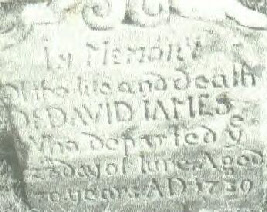Children of Joshua Pickering James (1818-1900) of Jefferson County, Ohio and Sarah
Ann Rogers (1820-1851):
1. Joseph Evan James: born June 16, 1842 in Madison County, Indiana; served in
the Union’s Company A, 16th Regiment, Indiana Volunteer Infantry during the Civil
War (1861-1865); died July 2, 1863 (aged 21) at the Battle of Gettysburg, Pennsylvania;
buried at Fall Creek Monthly Meeting burial grounds, Madison County, Indiana.
2. Charles Rogers James: born January 13, 1844 in Fall Creek Township, Madison
County, Indiana; served in the Union’s Company A, 16th Regiment, Indiana Volunteer
Infantry during the Civil War (1861-1865); married November 18, 1868 in Madison County,
Indiana to Tabitha Shields Morton (1844-1919); died July 29, 1906 (aged 62) in Madison,
Jefferson County, Indiana; buried at Fall Creek Monthly Meeting burial grounds, Madison
County, Indiana; known children include: Joseph E. James, Morton J. James, Sarah
A. James, Benjamin James, Lucie W. James, George H. James, Lottie Edna James and
Chester James.
3. Rebecca Pickering James: born April 5, 1846 in Madison County, Indiana; married
November 19, 1868 at Fall Creek Meetinghouse, Madison, County, Indiana to Solomon
Fussell Hardy (1837-1909), son of Neal Hardy (1803-1869) and Elizabeth Roberts Fussell
(1810-1888); died June 13, 1922 (aged 76) in Pendleton, Madison County, Indiana;
buried at Friends Cemetery, Fall Creek Township, Madison County, Indiana; known children
include: Charles Neal Hardy, John Hardy, Horace Greeley Hardy, Joseph James Hardy,
Elizabeth Roberts Hardy, Thomas Morris Hardy, Roscoe Whittier Hardy and Solomon Frank
Hardy.
4. Mary Margaret James: born March 2, 1848 in Madison County, Indiana; married
1879 to John Harden (1828-1911), son of William D. Hardin (1795-1882) and Esther
Leonard (1800-1881); died May 30, 1925 (aged 77) in Montpelier, Blackford County,
Indiana; known children include: Shirley Harden and James Newman Harden.
5. Elizabeth R. James: born August 2, 1850 in Madison County, Indiana; married
to George Cooper; died April 25, 1883 in Madison County, Indiana; known children
include: Lee Cooper and Lewis Cooper.
____________________________________________________________________________________________________
Notes:
Joshua James (1818-1900) was the son of Evan James (1784-1844) of Washington County,
Pennsylvania and Rebecca Pickering (1789-1848).
____________________________________________________________________________________________________
Sources:
See, Records of the James Family Archives.
See, "United States Census, 1850," database with images, FamilySearch (https://familysearch.org/pal:/MM9.1.1/MHJT-MXL
: 9 November 2014), household of Joshua T James, Madison county, part of, Madison,
Indiana, United States; citing family 523, NARA microfilm publication M432 (Washington,
D.C.: National Archives and Records Administration, n.d.).
See, "United States Census, 1860", database with images, FamilySearch (https://familysearch.org/pal:/MM9.1.1/M4N6-47T
: 30 December 2015), household of Joshua P James, 1860.
See, "United States Census, 1870," database with images, FamilySearch (https://familysearch.org/pal:/MM9.1.1/MXFH-V1Z
: 17 October 2014), household of Joshua P James, Indiana, United States; citing p.
15, family 127, NARA microfilm publication M593 (Washington D.C.: National Archives
and Records Administration, n.d.); FHL microfilm 545,835.
See, "United States Census, 1900," database with images, FamilySearch (https://familysearch.org/pal:/MM9.1.1/M99N-7ST
: accessed 23 July 2017), household of John Harden, Lagro Township (part south of
Wabash & Salamonie Rivers), Wabash, Indiana, United States; citing enumeration district
(ED) 115, sheet 3A, family 52, NARA microfilm publication T623 (Washington, D.C.:
National Archives and Records Administration, 1972.); FHL microfilm 1,240,410.
____________________________________________________________________________________________________
Virtual Memorials on “Find A Grave” Website:
Joseph Evan James (1842-1863), Memorial ID No. 8310211, by Judy Stevens, added January
23, 2004.
Charles Rogers James (1844-1906), Memorial ID No. 8308708, by Judy Stevens, added
January 23, 2004.
Tabitha Shields Morton James (1844-1919), Memorial ID No. 8310217, by Judy Stevens,
added January 23, 2004.
Rebecca James Hardy (1846-1922), Memorial ID No. 8257421, by Judy Stevens, added
January 10, 2004.
Solomon Fussell Hardy (1837-1909), Memorial ID No. 8308373, by Judy Stevens, added
January 23, 2004.
____________________________________________________________________________________________________
Updated: November 21, 2022
